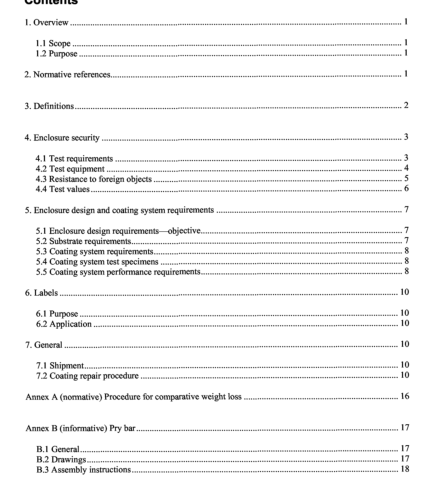IEEE C57.12.29-2014 pdf download.IEEE Standard for Pad-Mounted Equipment- Enclosure Integrity for Coastal Environments
3. Definitions
For the purposes of this standard, the following terms and definitions apply. ïñe Authoritative Dictiona y ofIEEE Standards [B10I3 should be referenced for terms not defined in this clause.
3.1 above grade: A term referring to an equipment use location above the high water line not intended for partial or total submersion. 3.2 axial force: A force applied along the axis of the pry bar from its handle to its pry tip.
3.3 coastal environment: The land area within 760 m (2500 ft) of the mean high water line.
3.4 conformance tests: Certain performance tests are conducted to demonstrate compliance with the applicable standards. The test specimen is normally subjected to all planned routine tests prior to initiation of the conformance test program.
NOTE-The conformance tests may, or may not, be similar to certain design tests. Demonstration of margins (capabilities) beyond the standard requirements is unnecessary
3.5 design tests: Tests made by the manufacturer to determine the adequacy of the design of a particular type or model of equipment or its component parts to meet its assigned ratings and to operate satisfactorily under normal conditions and under special conditions if specified. These tests may be used to demonstrate compliance with applicable standards of the industry.
NOTE-Design tests, sometimes called type tests, are made on representative apparatus or prototypes to verify the validity of design analysis and calculation methods and to substantiate the ratings assigned to all other apparatus of basically the same design. These tests may also be used to evaluate the modification of a previous design and to ensure that performance has not been adversely affected. Test data from previous similar designs may be used for current designs, where appropriate. Once made, the tests need not be repeated unless the design is changed so as to modify performance.
3.6 dry film thickness: Thickness of any applied coating(s) measured after curing.
3.7 enclosure security: The completely assembled apparatus will resist unauthorized entry when tested in accordance with the procedures of this standard.
3.8 gel coat: The material that provides the inhibition for ultraviolet protection and color to the fiber reinforced plastic (FRF’).
3.9 padlock A locking device specified by the user that will prevent the disengagement of the pentahead device. (e.g., key or combination lock, one-time or twist lock, single-use lock, or similar device.)
3.10 pad-mounted enclosure: An enclosure containing electrical apparatus, typically located outdoors at ground level where the general public has direct contact with the exterior surfaces of the equipment. The general construction of this equipment shall be such that authorized personnel may obtain access to the apparatus inside the equipment compartment( s).
3.11 prying leverage: A force at right angles to the handle times the distance from this force to the point of insertion of the pry tip into a joint, crevice, or similar opening in enclosure.
3.12 routine tests: Tests made for quality control by the manufacturer on every device or representative samples, or on parts or materials as required to verify during production that the product meets the design specifications and applicable standards.
NOTE l-Certain quality assurance tests on identified critical parts of repetitive high-production devices may be tested on a planned statistical sampling basis.
NOTE 2-”Routine tests” are sometimes called “production tests.”
3.13 substrate: The material that provides structural integrity to the enclosure.
4. Enclosure security
4.1 Test requirements
In addition to passing the tests defined in this standard, the construction of pad-mounted enclosure shall comply with the requirements of 4.1.1 through 4.1.9.
4.1.1 Enclosure mounting
The bottom edge of the enclosure shall provide for flush mounting on a flat, rigid mounting surface.
4.1.2 Water resistance
The enclosure shall restrict the entry of water (other than flood water) into the enclosure so as not to impair the operation of the apparatus inside.IEEE C57.12.29 pdf download.IEEE C57.12.29-2014 pdf download
IEEE C57.12.29-2014 pdf download

Leave a Reply